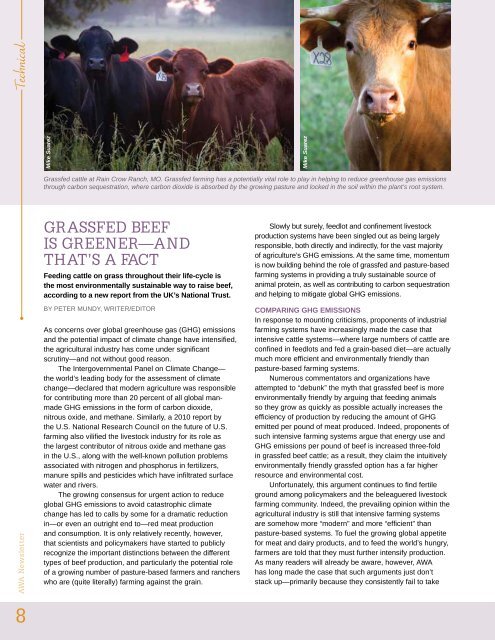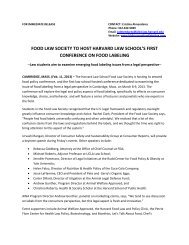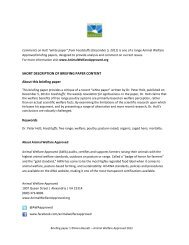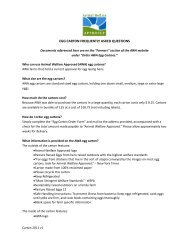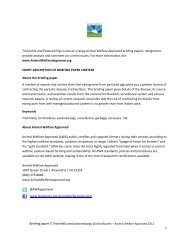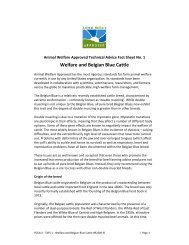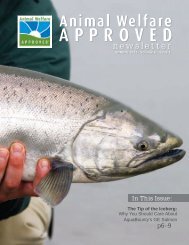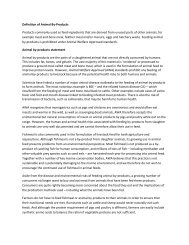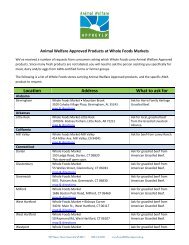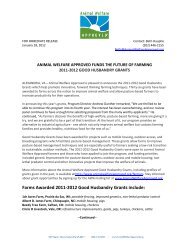Summer 2012 Animal Welfare Approved Newsletter
Summer 2012 Animal Welfare Approved Newsletter
Summer 2012 Animal Welfare Approved Newsletter
You also want an ePaper? Increase the reach of your titles
YUMPU automatically turns print PDFs into web optimized ePapers that Google loves.
AWA <strong>Newsletter</strong> Technical<br />
Mike Suarez<br />
Grassfed cattle at Rain Crow Ranch, MO. Grassfed farming has a potentially vital role to play in helping to reduce greenhouse gas emissions<br />
through carbon sequestration, where carbon dioxide is absorbed by the growing pasture and locked in the soil within the plant’s root system.<br />
Grassfed Beef<br />
is Greener—And<br />
That’s a Fact<br />
Feeding cattle on grass throughout their life-cycle is<br />
the most environmentally sustainable way to raise beef,<br />
according to a new report from the UK’s National Trust.<br />
By peter mundy, writer/editor<br />
As concerns over global greenhouse gas (GHG) emissions<br />
and the potential impact of climate change have intensified,<br />
the agricultural industry has come under significant<br />
scrutiny—and not without good reason.<br />
The Intergovernmental Panel on Climate Change—<br />
the world’s leading body for the assessment of climate<br />
change—declared that modern agriculture was responsible<br />
for contributing more than 20 percent of all global manmade<br />
GHG emissions in the form of carbon dioxide,<br />
nitrous oxide, and methane. Similarly, a 2010 report by<br />
the U.S. National Research Council on the future of U.S.<br />
farming also vilified the livestock industry for its role as<br />
the largest contributor of nitrous oxide and methane gas<br />
in the U.S., along with the well-known pollution problems<br />
associated with nitrogen and phosphorus in fertilizers,<br />
manure spills and pesticides which have infiltrated surface<br />
water and rivers.<br />
The growing consensus for urgent action to reduce<br />
global GHG emissions to avoid catastrophic climate<br />
change has led to calls by some for a dramatic reduction<br />
in—or even an outright end to—red meat production<br />
and consumption. It is only relatively recently, however,<br />
that scientists and policymakers have started to publicly<br />
recognize the important distinctions between the different<br />
types of beef production, and particularly the potential role<br />
of a growing number of pasture-based farmers and ranchers<br />
who are (quite literally) farming against the grain.<br />
Mike Suarez<br />
Slowly but surely, feedlot and confinement livestock<br />
production systems have been singled out as being largely<br />
responsible, both directly and indirectly, for the vast majority<br />
of agriculture’s GHG emissions. At the same time, momentum<br />
is now building behind the role of grassfed and pasture-based<br />
farming systems in providing a truly sustainable source of<br />
animal protein, as well as contributing to carbon sequestration<br />
and helping to mitigate global GHG emissions.<br />
Comparing GHG EmissionS<br />
In response to mounting criticisms, proponents of industrial<br />
farming systems have increasingly made the case that<br />
intensive cattle systems—where large numbers of cattle are<br />
confined in feedlots and fed a grain-based diet—are actually<br />
much more efficient and environmentally friendly than<br />
pasture-based farming systems.<br />
Numerous commentators and organizations have<br />
attempted to “debunk” the myth that grassfed beef is more<br />
environmentally friendly by arguing that feeding animals<br />
so they grow as quickly as possible actually increases the<br />
efficiency of production by reducing the amount of GHG<br />
emitted per pound of meat produced. Indeed, proponents of<br />
such intensive farming systems argue that energy use and<br />
GHG emissions per pound of beef is increased three-fold<br />
in grassfed beef cattle; as a result, they claim the intuitively<br />
environmentally friendly grassfed option has a far higher<br />
resource and environmental cost.<br />
Unfortunately, this argument continues to find fertile<br />
ground among policymakers and the beleaguered livestock<br />
farming community. Indeed, the prevailing opinion within the<br />
agricultural industry is still that intensive farming systems<br />
are somehow more “modern” and more “efficient” than<br />
pasture-based systems. To fuel the growing global appetite<br />
for meat and dairy products, and to feed the world’s hungry,<br />
farmers are told that they must further intensify production.<br />
As many readers will already be aware, however, AWA<br />
has long made the case that such arguments just don’t<br />
stack up—primarily because they consistently fail to take<br />
8


